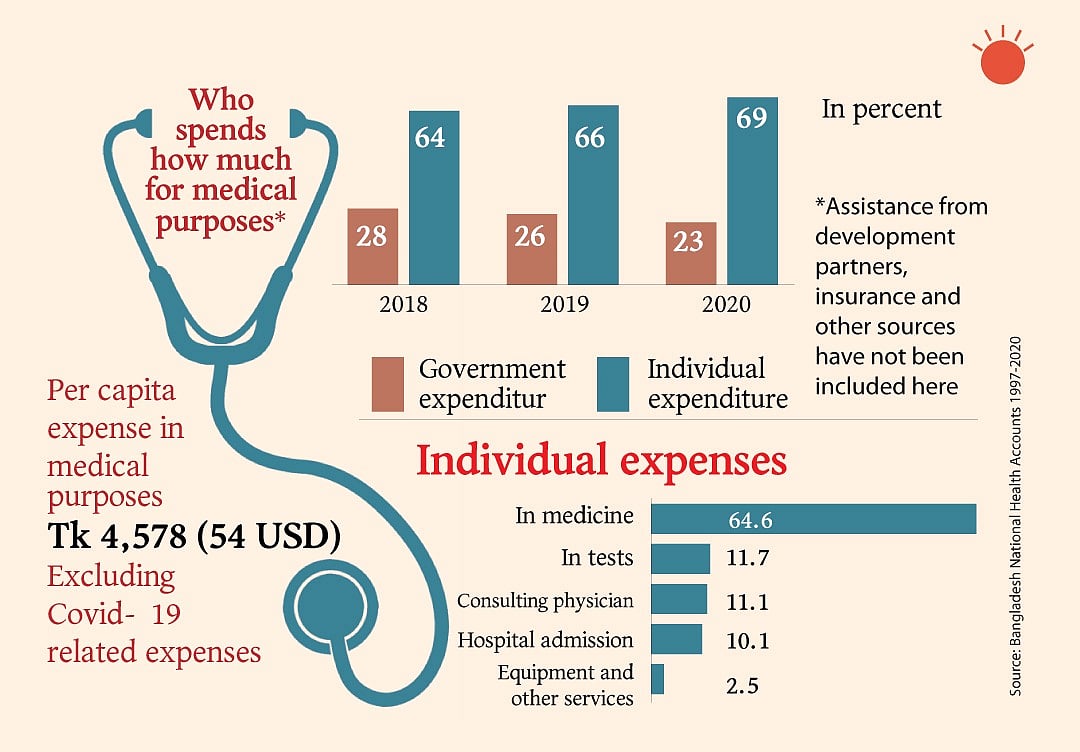
Healthy life is becoming costlier for the people of Bangladesh as the government’s expenses for the medical purposes is decreasing every year while that of the people is soaring day in day out, said a report of the health ministry.
Currently, people are bearing the three-fourth of the expenditure, revealed the report, published by the Health Economics Unit (HEU) of the ministry.
The government spent 28 per cent of total expenditure in 2018, which was 26 per cent in 2019 and 23 per cent in 2020, a gradual dip, the statistics of the HEU added.
Individual’s expenses in those years were 64, 66 and 69 per cent respectively. The tendency of rising expenses of the individual is not only over the last three years. This is a trend of for more than last two decades, said the Bangladesh National Health Accounts 1997-2020, a report of the health ministry’s Health Economics Unit.
The 97-page report, released at a workshop in a Dhaka hotel on Wednesday, did not include the expenditure of Covid-19.
Earlier, the health ministry and the health economics unit published five reports on financing and expenditure in the health sector.
Health minister Zahid Maleque, high officials of the health ministry and its different departments, representatives of different UN bodies, public health experts, researchers and university teachers were present in the programme.
Many people sell their land or property, give up their last resorts, for the treatment of cancer, kidney diseases or paralysis. Many people are becoming poorer because of treatment for these diseasesMajor General Mohammad Yousuf, DGDA director general
Speaking at the programme, World Health Orgnisation’s Bangladesh representative Bardan Jung Rana said if 69 per cent of total expense is made at the individual level, then this is a hindrance to achieving universal health safety.
Maya Vandenent, chief of health, UNICEF Bangladesh, said higher individual expense than the government means for many the medical expense is disastrous. Many people go below poverty level for this expense.
In a global report published at the end of last year, the WHO said 24 per cent people in Bangladesh have been incurring massive expenses while meeting the medical expenses, over 6.2 million people are falling below the poverty level due to medical expenses and 16 per cent households stop taking medical care as its costlier.
Who is spending and how much
It was said in the programme that the per capita income is on the rise due to development in the economic sector. As per the report, the per capita medical expenditure per annum is US $54, which is Tk 4,578 if $1 equals to Tk 84.77. The expense in 2017 was $37 while in 2014 it was $33. The expenditure, however, is less than Sri Lanka or Maldives.
Higher individual expense than the government means for many the medical expense is disastrous. Many people fall below poverty level for this expenseMaya Vandenent, chief of health, UNICEF Bangladesh
The total expenditure in the health sector in 2020 was over Tk 777.34 billion, said the report. Of the amount, individual or household level expense was 68.5 per cent while the government bore 23.1 per cent of the cost and development partners bore 5 per cent. The remaining 3.3 per cent of the cost was carried by private organisations and NGOs.
About 93 per cent of the government expenses in the health sector comes through the health ministry while 1.6 per cent through the local government and the remaining 5.4 per cent through other ministries.
Subrata Paul, the focal person of Bangladesh Health Accounts cell, presented the data of financing and expenditure at the programme. He said out of the total individual expenses, 54 per cent is spent by the richest people while the poorest people spend only 4 per cent.
Talking at the event, health minister Zahid Maleque said it could be that the poor people takes the service less. But it won’t be appropriate to say that they are given less services, he added
Most of the expense goes to medicine
The report delineated sector-wise expenses as well. According to that, most of the expense (64.6 per cent) goes to medicine. The remaining amount of money is spend in conducting tests, consulting physicians, hospital admission and buying other services.
Several discussants expressed concerns over expenditure in the medicine in the programme on Wednesday.
Directorate General of Drug Administration (DGDA) director general Major General Mohammad Yousuf said many people sell their last resorts, land or property, for the treatment of cancer, kidney disease or paralysis. Many people are becoming poorer for treatment of these diseases.
He further said the price of medicine would come down if the pharmaceutical companies stop aggressive marketing policy, costlier packaging and giving presents.
WHO’s Bangladesh representative Bardan Jung Rana said it is essential to make emergency medicines easily available to decrease expense in the sector.
Difference in expense
Dhaka division tops the list with most expenses (37 per cent). Chattogram is in the second spot with 24 per cent and Rajshahi in the third with 10 per cent of total medical expenses in the country. The expense in Khulna and Sylhet division is 9 and 7 per cent respectively. The expense is 5 per cent in Barishal and Rangpur divisions while it is 3 per cent (the least) in Mymensingh division.
Per capita expenses are about Tk 4,578 but this is not equally distributed among people from all divisions. Per capita expense of the people from Mymensingh division is Tk 2,060 while the amount is Tk 7,039 for the people living in Dhaka division.
No explanation of this difference was given at the event.
It was said that the government expenditure in the health sector has to be increased and steps have to be taken to decrease the price of medicine. Proper use of the government allocation also has to be ensured. At the same time, the government’s surveillance and supervision have to be increased.